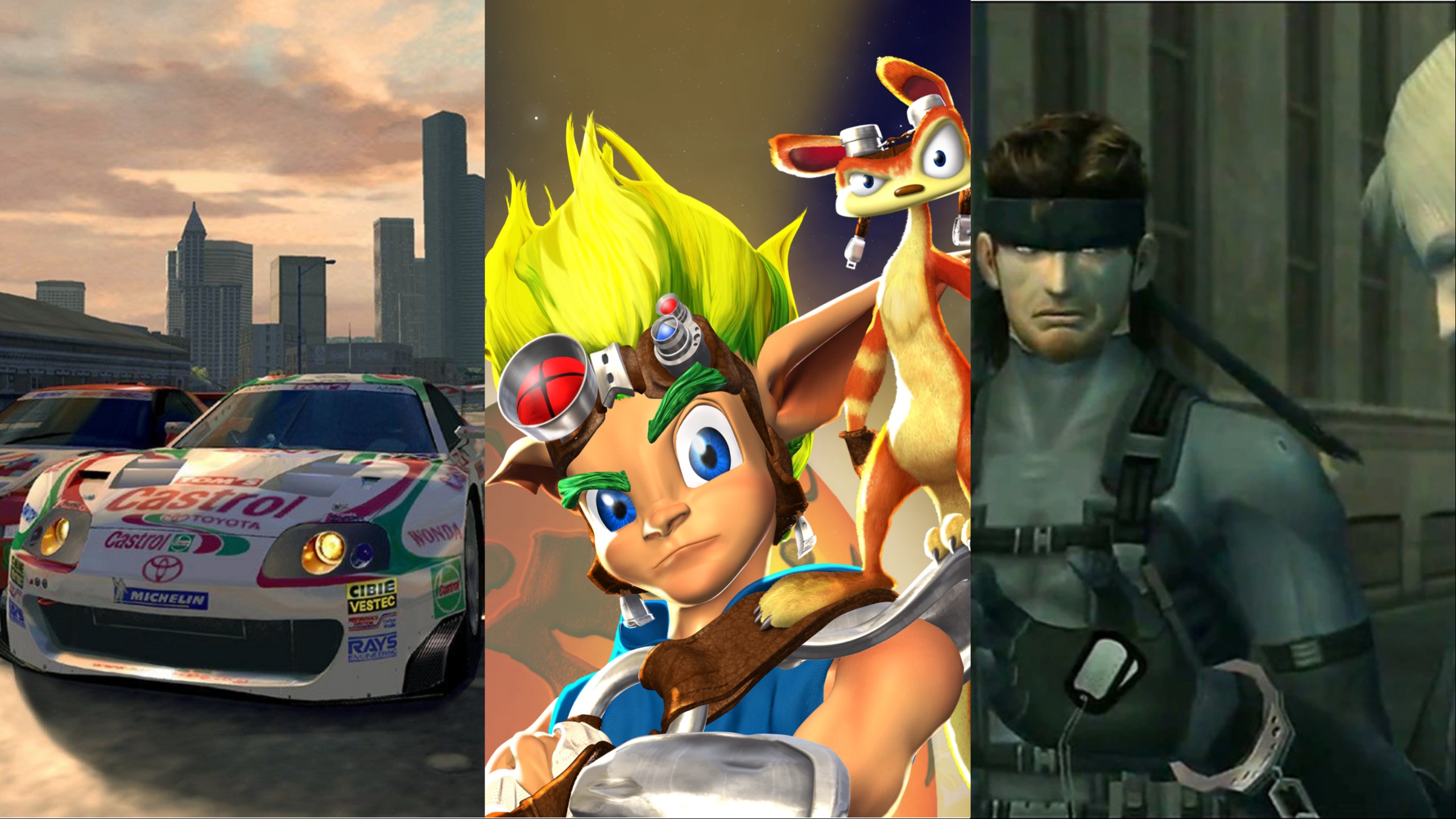
When looking back at some of the other games that were ahead of their time, I started to realize that there was a logical cut-off point for this particular topic. After all, it’s kind of hard for a game to be ahead of its time when we haven’t really had enough time to properly analyze its potentially once-overlooked or underappreciated impact. That makes it difficult to look at games released for slightly more modern consoles like the Nintendo Wii, Xbox 360, and PlayStation 2 in the same context.
Then I realized that the PS2 was released nearly 25 years ago. Though that revelation made me briefly confront my mortality, it also shined a light on some of the ways we sometimes fail to appreciate how much of a post-PS2 world we live in. The PlayStation 2 is the best-selling video game console ever, and many of its best games enjoyed similar levels of success. Even still, there are some PS2 games that were looking so far ahead that we may have not been able to fully appreciate what their creators did when we were caught up in the whirlwind of that significant era in the evolution of gaming.
15. Gran Turismo 4
Given how video game graphics typically evolve, it’s rare to be able to praise a game for its photorealistic visuals 19 years after its debut. Yet, Gran Turismo 4 remains a visually stunning technical masterpiece. The Gran Turismo 4 team pushed the PS2 to its absolute limits (and even managed to squeeze some early HD technology out of the console), and the results most certainly speak for themselves.
However, it’s Gran Turismo 4’s incredible photo mode that earns it a spot on this list. For all intents and purposes, Gran Turismo 4 was the first game to feature what we now think of when we think of video game photo modes. There were some precursors to that concept, but Gran Turismo 4’s use of advanced camera control options, filters, and frames would gradually become the industry standard in the coming years. Of course, it didn’t hurt that everything in the game looked worthy of being framed in the first place.
14. The Bouncer
While The Bouncer certainly earned many of the negative reviews it received in its day, the game deserves more credit for being one of the first PS2 titles that really tried to explore everything the new console could do. Its use of advanced ragdoll physics alone should at least earn it a little more respect than it often gets.
However, it’s The Bouncer’s implementation of pressure-sensitive buttons that remains its most impactful early innovation. While the PlayStation 2’s DualShock 2 controller wasn’t technically the first input device to play with the idea of pressure sensitivity, it was the first major controller to standardize that concept and make it more practical. The Bouncer not only utilized that function incredibly early on but did so in a way that added some much-needed depth to the beat-em-up gameplay. Countless action titles (and many other games) have since expanded upon that then-new input option.
13. The Adventures of Cookie & Cream
The Adventures of Cookie & Cream is one of the PS2’s most tragically underrated titles. This cutesy PS2 game was not only hilariously developed by FromSoftware (the studio that would go on to make Dark Souls) but offered new PS2 owners the kind of same-screen co-op experience we never seem to get enough of. However, this game makes this list because of what it did with one controller rather than two.
The Adventures of Cookie & Cream allowed two players to share one PS2 controller to play the game simultaneously. The game essentially treated each of the DualShock 2’s analog sticks like a separate controller for each of its playable characters. That same control scheme also allowed solo players to enjoy this co-op title in a rather unique way. That innovative method of using one controller to simultaneously control two characters would later serve as the backbone for titles like 2013’s critically acclaimed Brothers: A Tale of Two Sons and was generally a huge step forward for unique same-screen co-op experiences.
12. Final Fantasy XI
The PS2 famously struggled to compete with the Xbox when it came to its library of online multiplayer titles. Even the Dreamcast is usually better remembered for its collection of online multiplayer games. However, Final Fantasy XI remains not just the PS2’s most notable online multiplayer title but a console online multiplayer experience so innovative that many modern titles still struggle to replicate its successes.
While Final Fantasy XI wasn’t the first console MMORPG (that honor goes to Phantasy Star Online), it was the first MMORPG to support cross-play between PC and console gamers. That feature meant that the console version of Final Fantasy XI needed to be as functionally similar to the PC version as possible. In 2002, the idea of a PC-worthy MMORPG working on a console still seemed like an impossible dream. Yet, the Final Fantasy XI team somehow made it happen. Final Fantasy XI‘s ambition not only necessitated the development of several PS2 software and hardware innovations but the PS2 version of the game remained supported up until 2016.
11. Red Faction
The PS2 never quite found that Halo killer that PlayStation fans dreamed of but the console still offered a solid collection of FPS titles that remains somewhat overlooked to this day. Yet, you could argue that none of those gamers were more important to the evolution of the genre and medium than 2001’s Red Faction.
Developer Volition’s innovative GeoMod Technology engine made Red Faction the first game to offer dynamic destructible environments that could be interacted with in real-time. While older games would allow you to destroy part of a level as part of a scripted sequence (or in a similarly limited fashion), Red Faction was the first game of its kind to let you destroy and alter large chunks of its environment as you saw fit. That also allowed you to explore new areas and come up with creative combat solutions. Numerous other developers would begin exploring similar concepts, though there honestly aren’t enough modern titles that feature advanced variations of this incredible mechanic.
10. Demon Chaos
Arguably the most obscure game on this list, 2005’s Demon Chaos certainly didn’t make much of an impact in its day. However, this Dynasty Warriors-like action game is arguably one of the most technically impressive PS2 titles ever made.
Like Dynasty Warriors, Demon Chaos often tasked you with defeating massive waves of enemies. However, Demon Chaos pushed the scope of that concept further than Dynasty Warriors (or any other game) ever dreamed of. How far? Well, Digital Foundry estimates that Demon Chaos was technically capable of rendering over 65,000 enemies on-screen at one time without dropping below 60 FPS. While subsequent games like Ninety-Nine Nights, Dead Rising, and Kameo: Elements of Power would become obsessed with rendering as many characters on-screen as possible, few (if any) games ever replicated Demon Chaos’ technical achievements in that area.
9. EyeToy Play
The PS2’s EyeToy accessory was essentially an elaborate webcam that allowed you to interact with what we now know as “mixed reality” games. Though the device’s major functions were largely limited to the EyeToy line of games, those games’ use of motion controls and image recognition software were (at the very least) precursors to what Nintendo would eventually do with the Wii hardware.
That’s certainly impressive, but you should really consider this entry to also be a nod toward the PS2’s built-in USB ports that made the EyeToy as functional as it was. We take consoles having USB ports for granted today, but the PS2’s early use of standardized USB ports may be the console’s most lasting hardware innovation.
8. Indigo Prophecy/Fahrenheit
Developer Quantic Dreams’ Indigo Prophecy (aka Fahrenheit) was a 2005 PS2 title that many gamers at the time didn’t know quite what to make of. It offered a blend of cinematic storytelling, QTE-style narrative choices, and largely puzzle-based gameplay that we’d rarely seen the likes of before. While most agreed that Indigo Prophecy was a deeply flawed experience, there was no denying the impact of its most ambitious ideas.
Of course, we now know Indigo Prophecy as the obvious forerunner to the games Quantic Dreams would later make (including Heavy Rain, Beyond Two Souls, and Detroit: Become Human). However, you could go even further and argue that this title’s unique structure ultimately helped inspire tiles like TellTale’s Walking Dead Series, Until Dawn, and even aspects of games like L.A. Noire.
7. Grand Theft Auto: San Andreas
Yes, you could certainly argue that Grand Theft Auto 3 deserves this spot for kicking down the doors of the industry and opening a lot of eyes toward the undeniable future of open-world games. Nearly 20 years after its release, though, the thing that impresses me most about GTA: Sand Andreas isn’t just the ways that it built upon GTA 3’s foundation in such a short amount of time but how it still alters our perception of modern open-world experiences.
Three years after GTA 3’s debut, San Andreas offered not just a significantly larger open world than the previous GTA games but a larger world packed with characters, stories, and a wealth of things to do. Granted, some of the game’s size can be attributed to digital smoke and mirrors that made everything seem bigger than it was, but I mean that as more of a compliment than a knock against the title. 20 years later, many gamers of a certain age will still tell you that even many modern open-world titles simply feel smaller than what San Andreas offered in its day.
6. Resident Evil Outbreak
This is a rather unique case of a game being ahead of its time in ways that almost caused me to leave it off this list. After all, Final Fantasy XI was an online PS2 game that not only came out before Resident Evil Outbreak but was far larger and more ambitious. Ultimately, though, I just couldn’t get over how perfectly “ahead of its time” described the Outbreak experience.
Capcom’s decision to release a Resident Evil game that practically demanded online co-op play (minus the option to play with largely useless AI companions) was a big swing that ultimately failed to catch on. However, that’s largely because of the numerous technical and logistical limitations that the project faced at that time. Many of those who played Outbreak in its day praised the game’s unique online multiplayer design, and many of those who play the game today are quick to heap similar praise upon it. Unfortunately, this game is nearly impossible to play in its intended form these days without investing a decent amount of time, money, and know-how into its set-up. If it had been released just a generation later, it would likely enjoy a much better legacy.
5. Metal Gear Solid 2
If you wanted to break Metal Gear Solid 2 down and examine it piece by piece, you could undoubtedly find numerous little technical and gameplay innovations that would impact numerous subsequent releases. Yet, few elements of Metal Gear Solid 2 were more obviously and impressively ahead of their time than the game’s story.
In its own ways, Metal Gear Solid 2 explores the impact of internet input on our collective mental health, manipulation of the media in the digital age, drone warfare, and the potential impact of government and AI technology on all of those things (and more). I say “in its own ways” as both a comment on Hideo Kojima’s strange way of doing nearly everything and the fact that we now have words to describe many of Metal Gear Solid 2’s biggest ideas that simply didn’t exist in 2001. It’s truly troubling to see how many of this movie’s thoughts and concerns about the future eventually came to pass.
4. The Mark of Kri
There were certainly 3D action games in the pre-PS2 era, but that genre had historically proven to be surprisingly tough to get right. While PS2 games like Devil May Cry and God of War certainly showed the industry better ways to do things, 2002’s The Mark of Kri may just be the most important PS2 action game that doesn’t get enough love.
The Mark of Kri’s central gameplay “gimmick” required you to mark multiple enemies around you with symbols that corresponded to the DualShock 2’s main face buttons (Square, X, Circle, and Triangle). By doing so, you could easily bounce between enemies by pressing the button you had assigned each of them. Though few picked up on the potential of that combat system at the time, Rocksteady would later use a variation of that concept for Batman: Arkham Asylum and change the design of 3D melee combat for years to come in the process.
3. Kill Switch
Inspired by the cover system seen in titles like Time Crisis and Metal Gear Solid 2 (see above), developer Namco USA decided to see if it was possible to create a 3D action experience that largely revolved entirely around a cover system. The result was 2003’s Kill Switch: a game that often asked you to bounce between sources of cover as you face off against generally superior odds.
Yes, we had seen cover systems in older action titles, but Kill Switch was really the first game to explore the idea that you could aggressively use cover as an offensive tactic rather than to simply avoid incoming damage. While Gears of War would later popularize and standardize such a mechanic, Kill Switch essentially invented the modern style of third-person shooting we see in so many action games.
2. Jak and Daxter: The Precursor Legacy
2001’s Jak and Daxter was practically sold on the promise that it featured “no loading times.” It must sound like such a minor thing these days, but at a time when loading screens were still accepted as a necessary nuisance, the idea that a game would offer a massive world not interrupted by such screens and long wait times seemed too good to be true.
Yet, that’s exactly what this game ended up offering. Jak and Daxter’s developers later admitted that they didn’t even realize how much they had overachieved by creating a game that featured virtually no loading screens for the bulk of the main experience. While Jak and Daxter’s sequels are generally superior in most respects, you have to give a lot of love to the game that forced the industry’s biggest studios to find ways to offer previously unfathomable levels of immersion.
1. Ico
It’s difficult to discuss Ico’s innovations via the same box-checking methods that apply to some other games. Yes, it clearly led to the impressive Shadow of the Colossus, and yes, it showed us that escort missions don’t have to suck in ways that Resident Evil 4 would later run with. However, even those advances fail to capture the scope of Ico’s accomplishments.
What Ico really did was change many of our expectations for how a game could make us feel and how it could weave our organic emotions into the interactive elements of the entire experience. By utilizing intentionally minimalist design elements (a bold decision at a time of escalating presentation options), developer Team Ico found ways to force you to appreciate the weight of even the most seemingly simple actions. The visuals, music, storytelling, and gameplay all existed in a harmonious way that remains difficult to properly describe simply because it was all designed to be experienced to properly be understood. Granted, that design philosophy probably contributed to Ico’s poor sales (although the game’s dreadful NA box art certainly didn’t help).
Years later, though, we’re enjoying the benefits of a generation of developers who played Ico and began to rethink even the basic tenets of the game design process. FormSoftware’s Hidetaka Miyazaki revealed that Ico was the game that awoke him to “the possibilities of the medium.”
The post 15 PlayStation 2 Games That Were Way Ahead of Their Time appeared first on Den of Geek.






